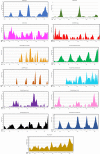Epidemiological trends of respiratory tract pathogens detected via mPCR in Australian adult patients before COVID-19
- PMID: 38166699
- PMCID: PMC10763466
- DOI: 10.1186/s12879-023-08750-7
Epidemiological trends of respiratory tract pathogens detected via mPCR in Australian adult patients before COVID-19
Abstract
Background: Respiratory tract infections (RTIs) are a major global health burden due to their high morbidity and mortality. This retrospective study described the epidemiology of respiratory pathogens in adults over a 5-year period at an Australian tertiary healthcare network.
Methods: All multiplex reverse transcription polymerase chain reaction respiratory samples taken between the 1st of November 2014 and the 31st of October 2019 were included in this study. Overall prevalence and variations according to seasons, age groups and sex were analysed, as well as factors associated with prolonged hospital and intensive care length of stay.
Results: There were 12,453 pathogens detected amongst the 12,185 positive samples, with coinfection rates of 3.7%. Picornavirus (Rhinovirus), Influenza A and respiratory syncytial virus were the most commonly detected pathogens. Mycoplasma pneumoniae was the most commonly detected atypical bacteria. Significant differences in the prevalence of Chlamydia pneumoniae and Human metapneumovirus infections were found between sexes. Longest median length of intensive care and hospital stay was for Legionella species. Seasonal variations were evident for certain pathogens.
Conclusions: The high rates of pathogen detection and hospitalisation in this real-world study highlights the significant burden of RTIs, and the urgent need for an improved understanding of the pathogenicity as well as preventative and treatment options of RTIs.
Keywords: Respiratory tract infections; Seasonal distribution of respiratory pathogens; Viral trends.
© 2023. The Author(s).
Conflict of interest statement
The authors declare no competing interests.
Figures
References
-
- Troeger C, et al. Estimates of the global, regional, and national morbidity, mortality, and aetiologies of lower Respiratory Infections in 195 countries, 1990–2016: a systematic analysis for the global burden of Disease Study 2016. Lancet Infect Dis. 2018;18(11):1191–1210. doi: 10.1016/S1473-3099(18)30310-4. - DOI - PMC - PubMed
MeSH terms
LinkOut - more resources
Full Text Sources
Medical



